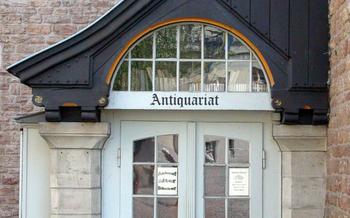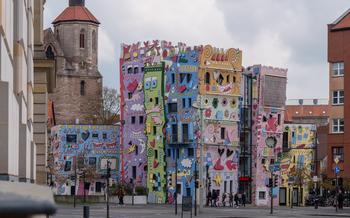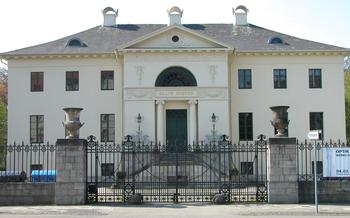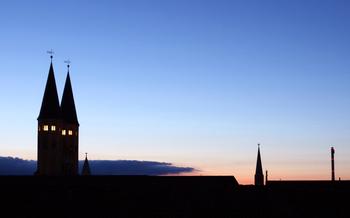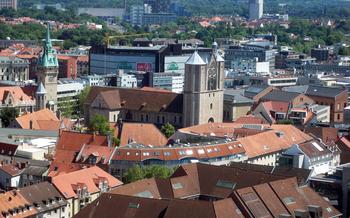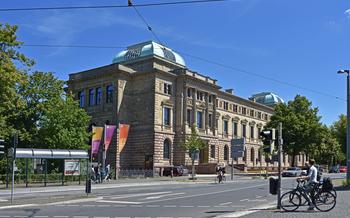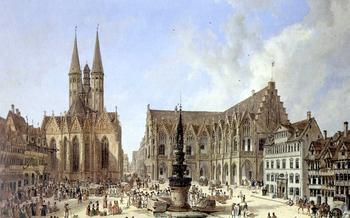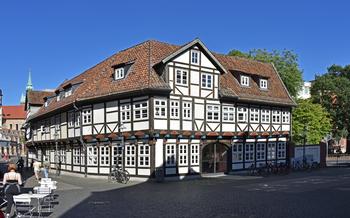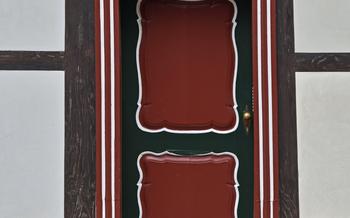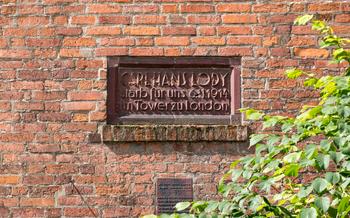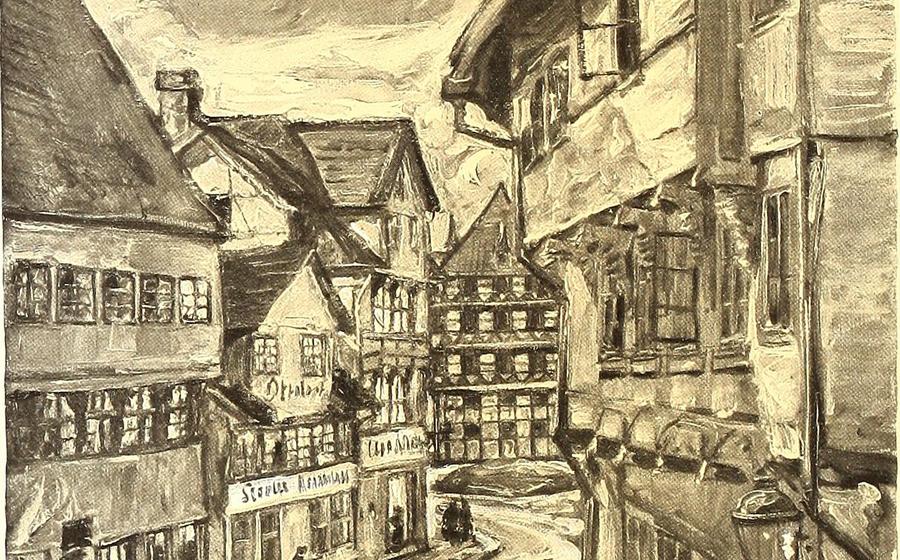
Alte Waage (Old Weigh House)
- The Alte Waage (Old Weigh House): A Historical Landmark in Braunschweig
- Exploring the Weighing Scales: A Symbol of Precision
- Trading Traditions in Braunschweig: A Rich History
- The Alte Waage: A Venue for Cultural Events
- Admire the Facade: A Masterpiece of Gothic Architecture
- Discover the Old Town Hall: A Neighboring Landmark
- Stroll Along the Oker River: A Scenic Promenade
- Discover the Happy Rizzi House: A Unique Architectural Gem
- Indulge in Local Delicacies: A Culinary Adventure
- Shop for Souvenirs: A Memorable Experience
- Take a Bike Tour: A Green and Active Way to Explore
- Plan Your Visit: Practical Information
- Insider Tip: Explore the Nightlife
The Alte Waage (Old Weigh House): A Historical Landmark in Braunschweig
The Alte Waage (Old Weigh House) stands as a historical landmark in the heart of Braunschweig, Germany. Its rich history dates back to the 13th century when it served as a crucial trading center in the city. The building's architectural features, such as its intricate carvings and gabled roof, reflect the Gothic style that was prevalent in the region during that time. As a symbol of precision and fairness, the Alte Waage played a vital role in regulating trade and ensuring the accuracy of weights and measurements. This historical landmark not only offers a glimpse into the past but also serves as a testament to the city's prosperous trading legacy.
Exploring the Weighing Scales: A Symbol of Precision
The Alte Waage is not just an architectural marvel but also a testament to the city's rich trading history, and the weighing scales played a pivotal role in this legacy. The scales were a symbol of precision and fairness in trade, ensuring that both buyers and sellers received their due. In the Middle Ages, weighing goods was a complex and crucial process, as it determined the value of the goods and the taxes to be paid. The scales at the Alte Waage were used to weigh a wide range of goods, including precious metals, spices, and agricultural products.
The scales were meticulously maintained and calibrated to ensure accuracy. Various types of scales were used depending on the weight of the goods being measured. Smaller scales were used for weighing precious metals like gold and silver, while larger scales were employed for weighing bulkier items such as grain and wool. The scales were operated by skilled weighmasters who possessed the knowledge and expertise to handle the delicate task of weighing accurately.
The significance of the weighing scales went beyond their practical function. They were a symbol of trust and integrity in trade transactions. Buyers and sellers relied on the accuracy and fairness of the scales to ensure that they received a fair deal. The scales also served as a deterrent against fraud and malpractices, as any discrepancies in weight could be immediately detected.
Trading Traditions in Braunschweig: A Rich History
Braunschweig, a city steeped in history, played a pivotal role in medieval trade routes. Situated along the Oker River, it served as a crucial hub for the exchange of goods between the North Sea and the Baltic Sea. The city's strategic location fostered the development of a thriving market system, attracting merchants from across Europe.
As a member of the Hanseatic League, a powerful alliance of trading cities, Braunschweig gained significant influence and prosperity. The Hanseatic League, established in the 13th century, aimed to protect and promote the interests of its member cities, regulating trade, establishing standardized weights and measures, and ensuring the safe passage of goods.
Braunschweig's membership in the Hanseatic League brought numerous advantages. The city became a major center for the import and export of goods, including wool, textiles, grain, timber, and metals. Merchants from Braunschweig traveled far and wide, establishing trade connections with cities across Europe and beyond.
The city's wealth and influence were reflected in its architecture, with grand merchant houses and guildhalls lining the streets. The Alte Waage, a testament to Braunschweig's trading heritage, stands as a symbol of the city's significance in medieval commerce.
The Alte Waage: A Venue for Cultural Events
The Alte Waage is not just a historical landmark but also a vibrant venue for cultural events. Throughout the year, it hosts a variety of exhibitions, art installations, concerts, performances, and historical reenactments. These events bring the building's rich history to life and offer visitors a unique opportunity to experience the cultural heritage of Braunschweig.
Exhibitions and art installations often showcase the works of local and international artists, providing a platform for creative expression and showcasing the city's vibrant art scene. Concerts and performances range from classical music recitals to contemporary dance performances, catering to diverse tastes and preferences. Historical reenactments transport visitors back in time, allowing them to witness scenes from the building's past and gain insights into the lives of its former occupants.
Attending a cultural event at the Alte Waage is a fantastic way to immerse yourself in the city's rich history and culture. Whether you are an art enthusiast, a music lover, or simply curious about the past, there is something for everyone to enjoy at this iconic venue.
Admire the Facade: A Masterpiece of Gothic Architecture
The Alte Waage boasts an awe-inspiring Gothic facade that is sure to captivate visitors. Adorned with intricate carvings and sculptures, the building's exterior is a testament to the skill and artistry of medieval craftsmen. The gabled roof, with its steep slopes and decorative finials, adds to the building's grandeur. The tower, which dominates the skyline, features an ornate spire that reaches towards the heavens. Intricate carvings depicting mythical creatures and biblical scenes adorn the tower, creating a visual feast that transports visitors back in time. The Alte Waage's facade is a true masterpiece of Gothic architecture and a must-see for anyone visiting Braunschweig.
Discover the Old Town Hall: A Neighboring Landmark
Standing side by side with the Alte Waage, the Old Town Hall (Altes Rathaus) is another architectural gem that reflects Braunschweig's rich history. Constructed in the 13th century, this Gothic masterpiece exudes an aura of grandeur and elegance. Its striking facade, adorned with intricate carvings and gabled windows, is a testament to the skill of medieval artisans.
Over the centuries, the Old Town Hall has served as the seat of local government and a gathering place for the city's merchants and traders. Within its walls, important decisions were made, laws were enacted, and justice was dispensed. Today, it continues to be a symbol of Braunschweig's civic pride and serves as a venue for official functions and special events.
Visitors to the Old Town Hall can admire its well-preserved interior, which features a grand staircase, vaulted ceilings, and ornate chandeliers. The building also houses a museum that showcases the history of Braunschweig and the surrounding region. Through interactive exhibits and historical artifacts, visitors can delve into the city's medieval past, its role in the Hanseatic League, and its cultural heritage.
Stroll Along the Oker River: A Scenic Promenade
The Oker River, a meandering waterway that gracefully bisects Braunschweig, offers a picturesque promenade for visitors to savor the city's charm. As you amble along the riverbank, a panorama of architectural wonders unfolds before your eyes. Gaze upon the Alte Waage, its Gothic facade mirrored in the tranquil waters, and admire the grandeur of the Braunschweig Cathedral, its spires reaching towards the heavens.
Bridges gracefully arch over the Oker, connecting the city center with its vibrant neighborhoods. Cross the bridges to explore the hidden gems that lie beyond, where quaint cafes, charming boutiques, and art galleries beckon you to discover their treasures.
For a unique perspective of Braunschweig's riverside beauty, embark on a leisurely boat tour. Glide along the gentle currents, passing beneath bridges and admiring the city's landmarks from a fresh vantage point. As you soak in the tranquility of the river, let the gentle breeze carry away your worries, leaving you fully immersed in the moment.
Whether you choose to stroll, cycle, or sail along the Oker River, this scenic promenade promises a delightful experience that will leave you with lasting memories of Braunschweig's allure.
Discover the Happy Rizzi House: A Unique Architectural Gem
Amidst the historic buildings of Braunschweig, the Happy Rizzi House stands out as a vibrant and playful architectural wonder. Designed by the renowned Friedensreich Hundertwasser, this unique structure is a testament to his extraordinary imagination and love for color. The facade of the building is a kaleidoscope of bright hues, adorned with whimsical patterns and ceramic tiles. The irregular windows, curved balconies, and colorful columns create a sense of movement and joy, inviting visitors to immerse themselves in a world of fantasy and creativity.
The Happy Rizzi House was completed in 2000 and has since become a symbol of Braunschweig's commitment to contemporary art and architecture. It serves as a residential building, with apartments and offices, and also houses a café and a gallery. The interior of the building is just as captivating as the exterior, with colorful staircases, mosaic floors, and unique design elements at every turn.
Visiting the Happy Rizzi House is a must for anyone interested in modern architecture and design. It is a place where imagination knows no bounds, and where visitors can experience the transformative power of art and color. Whether you choose to admire its vibrant facade from afar or explore its whimsical interiors, the Happy Rizzi House is sure to leave a lasting impression.
Indulge in Local Delicacies: A Culinary Adventure
Braunschweig is a city that celebrates its culinary heritage with passion and pride. From traditional German dishes to international cuisines, the city's culinary scene offers a diverse range of flavors that will tantalize your taste buds.
For a true taste of Braunschweig, indulge in the hearty and flavorful Braunschweiger Mettwurst, a coarse-grained smoked sausage that is a local delicacy. Another must-try is the Braunschweiger Mumme, a dark and malty beer that has been brewed in the city for centuries.
To experience the vibrant culinary scene, head to the Braunschweiger Wochenmarkt, a bustling weekly market where local vendors showcase their fresh produce, artisanal cheeses, and homemade delicacies. Here, you can savor the aromas of freshly baked bread, sample regional specialties, and enjoy the lively atmosphere of the market.
For a memorable dining experience, reserve a table at one of the city's top-rated restaurants. Zur Linde is a traditional German restaurant that serves classic dishes in a cozy and charming setting. Das Lokal offers a modern take on German cuisine, with a focus on seasonal and locally sourced ingredients.
Whether you're craving traditional German fare or looking to explore international flavors, Braunschweig has something to offer every palate. Embark on a culinary adventure and discover the delicious treasures that this vibrant city has to offer.
Shop for Souvenirs: A Memorable Experience
Braunschweig offers a delightful shopping experience with a wide range of unique souvenirs to cherish. From traditional crafts to local delicacies and modern designs, there's something for every taste. The city center is home to numerous specialty shops and boutiques, each offering a curated selection of items.
For those seeking authentic souvenirs, the Altstadtmarkt is a must-visit. Here, you'll find stalls selling traditional German handicrafts, such as wooden carvings, pottery, and intricate glass ornaments. The Happy Rizzi House, with its vibrant facade, also houses a gift shop selling unique items inspired by the artist's colorful designs.
To savor the local flavors of Braunschweig, head to the farmers' market on the Kohlmarkt. Here, you can purchase fresh produce, artisanal cheeses, and freshly baked bread. The market is a great place to sample local specialties like "Braunschweiger Mumme," a traditional dark beer, or "Braunschweiger Mettwurst," a smoked sausage.
For those who prefer modern designs, the shopping district around the Schloss Arkaden mall offers a variety of contemporary boutiques and concept stores. Here, you'll find stylish clothing, homeware, and accessories by local and international designers.
To make your shopping experience even more enjoyable, consider joining a guided tour. These tours often include visits to hidden gems and provide insights into the city's history and culture. Whether you're looking for a unique gift for a loved one or a special memento to remember your trip, Braunschweig has something for everyone.
Take a Bike Tour: A Green and Active Way to Explore
Braunschweig is renowned for its eco-friendly initiatives and offers an extensive network of bike paths, making it a delight for cyclists of all levels. Whether you're a seasoned enthusiast or just seeking a leisurely ride, exploring the city on two wheels is an invigorating experience.
Rent a bike from one of the many rental shops in the city center and embark on a scenic journey through Braunschweig's charming streets and green spaces. The Oker River Bike Path is a popular choice, offering picturesque views along the riverbanks. For a more adventurous route, head to the Südsee, a former gravel pit transformed into a beautiful lake surrounded by nature trails.
Guided bike tours are also available, providing insights into the city's history and hidden gems. These tours often include visits to local landmarks, parks, and culinary stops to sample Braunschweig's specialties.
Suggested Route for a Scenic Ride:
Start at the Alte Waage and follow the Oker River Bike Path along the riverbank. Cross the Friedrich-Wilhelm Bridge and continue to the Südsee, where you can enjoy a relaxing break at the lakeside. From there, cycle back towards the city center, passing by the Happy Rizzi House and the Braunschweig Cathedral. The total distance is approximately 10 kilometers, and the route is mostly flat, making it suitable for all fitness levels.
Plan Your Visit: Practical Information
Before embarking on your journey to the Alte Waage, it's essential to plan your visit to ensure a smooth and enjoyable experience. Here are some practical considerations to keep in mind:
-
Opening Hours: The Alte Waage is open to the public from Tuesday to Sunday, with varying hours depending on the season. During the summer months (April to October), it is typically open from 10 am to 6 pm, while in the winter months (November to March), the hours are slightly shorter, from 10 am to 4 pm.
-
Ticket Prices and Discounts: Admission to the Alte Waage is free of charge, allowing you to explore the museum and its exhibits without any financial burden. However, some special events or exhibitions may require a small fee. It's always a good idea to check the museum's website or inquire at the information desk for any additional costs.
-
Accessibility and Facilities: The Alte Waage is committed to ensuring accessibility for all visitors. The building is wheelchair accessible, with ramps and elevators provided to facilitate easy movement throughout the museum. Additionally, guided tours and audio guides are available in various languages to enhance the experience for non-German speakers.
Insider Tip: Explore the Nightlife
Braunschweig offers a vibrant nightlife scene, featuring an eclectic mix of bars, clubs, and live music venues. Immerse yourself in the city's lively atmosphere as you discover hidden gems and local favorites. Start your evening with a refreshing drink at one of the many cozy bars scattered throughout the city center. As the night progresses, venture into the vibrant club scene, where you can dance the night away to the latest beats. Don't miss the opportunity to experience live music performances at venues such as the Brunsviga club or the Kulturzentrum Brunsviga, which showcase local and international artists. For a unique experience, head to the historic Magniviertel district, where you'll find a cluster of trendy bars and restaurants housed in charming medieval buildings. Whatever your preference, Braunschweig's nightlife has something to offer everyone. So, embrace the city's energetic ambiance and let the rhythm of the night guide you.
